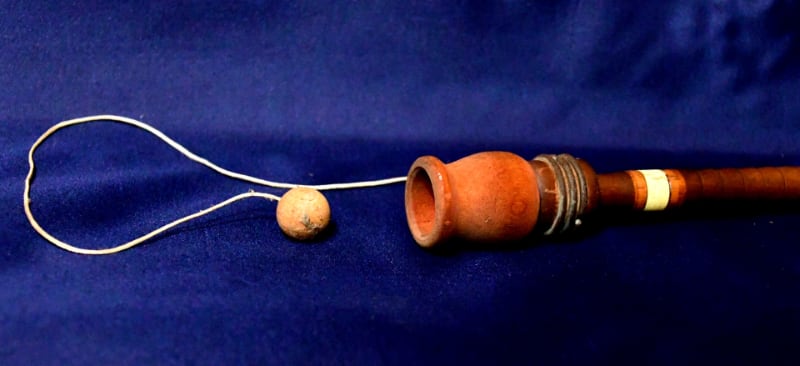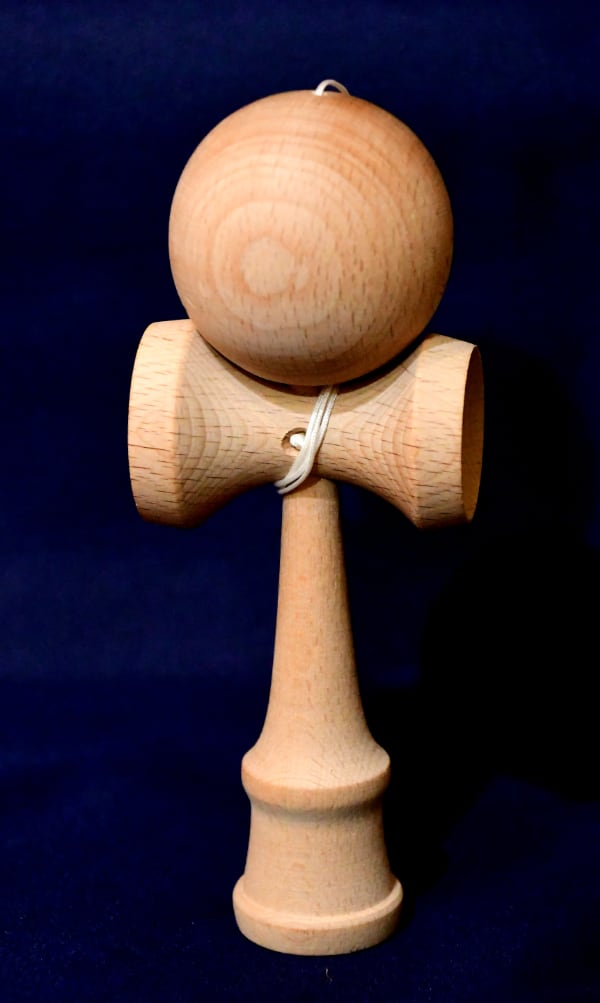
True, it’s a little late to be talking about Christmas shopping, but throughout the year we need to give gifts from time to time, often to young people, so I don’t think it’s a waste of time to discuss presents a little even at this late date.
(By the way, illiterate marketers and those who want to sound trendy notwithstanding, the word “gift” is not a verb. The correct verb is “give.” You give someone something, you do not gift it to or at them — the marketers haven’t figured the preposition out — and if you propose otherwise to me I’ll not take you seriously on that or any other subject.)
I have little nephews and a niece, and when time comes to select a present for one or more of them I try to give it some consideration. The goal is particularly to find something to take their eyes off of screens. Kids may occasionally learn something from television, tablet, or computer, but growing up ought to involve physical coordination, a degree of physical fitness — moving around, being active rather than passive. Children, and by that term I mean anyone under about 40, it seems, consider exercise to be the playing of video games. I try to select gifts that battle this trend.
But when seeking a gift that promotes physical activity, something more is needed: it needs to be interesting, maybe as addictive as a computer game but in a good way.
I was at a loss until I saw a news report from overseas. It had to do with a Japanese company that was producing its traditional New Year kendama. It showed the things, and they looked pretty interesting.
You might or might not be familiar with the cup-and-ball toy. It has been made for close to 500 years. A small ball is attached by a piece of string to a “cup,” often a handle with a small cup at the top. The game is played by swinging the ball into the air at the end of the string, then catching it in the cup, which is only slightly bigger than the ball itself. It is more difficult than it looks, but it is very satisfying when one gets good at it. I was given (not gifted, dammit) one many years ago, and it is one of my few possessions the whereabouts of which I always know, because it is a lot of fun.
When the cup-and-ball made its way to Japan about the time of the American revolution the Japanese were quick to make improvements. Soon, the handle, called the ken, had sprouted a pointed stick where the cup had been, and there was now a corresponding hole in the ball, called the tama. If you think it’s hard to catch a ball in a cup, try lining it up so that a stick will go into a hole in a ball swinging from a string. The cup became many cups, typically one on each side (making it look like the emergency sirens atop the municipal building downtown), and one at the bottom of the handle. Nor were these really cups, but instead concave places in cone-shaped areas. It was now much more difficult to play.

It’s thought of as a toy for kids, but that’s not how the ken-tama, later kendama, was originally used. Instead, it was a game played in drinking establishments — a pretty powerful field sobriety test, I think. And given my level of skill, I’d have been sent home after no drinks at all.
The kendama continued to be a popular toy in Japan and a few other countries. But recently, while no one was looking, it has begun to take off elsewhere. You would not believe what kids are doing with it. You could think of it as being somewhere among skateboarding and martial arts (though it is not a weapon) and juggling. With a little practice — okay, a lot of practice — one can do some impressive tricks. The more you get into it, the more elaborate the tricks become. (Though I confess that watching kendama tricks is not as entertaining to me as I had hoped.) There is a zen to it. A couple of California guys made a short and interesting documentary, “The Way of Kendama.”
You might think of it as a bit like the yoyo tricks popular back when possessing skills was considered desirable. The late Tommy Smothers performed as the Smothers Brothers opening act in his “Yoyo Man” character. The Duncan Toys Company used to send “Yoyo Champions” around the country to demonstrate yoyo tricks and promote yoyos. The similarity is not lost on today’s wood-and-string-toy enthusiasts. A lot of kendama masters are yoyo masters, too, and Duncan sells kendama.
So it seemed like just the thing for the kids in my family.
Kendama shopping can be a nightmare. There are many companies making all kinds of kendama that look pretty much the same but vary in price from $10 or so to — I’m not making this up — $1000 or more. A simple task became a complicated one. In case you have decided to follow the way of kendama, let me clear a bit of a path for you.
Kendama are typically made of beech or maple, though sometimes laminated bamboo or exotic woods are employed. By all accounts maple ones are the best among affortable kendama, because they feel good in the hand and because they are less likely to chip. (If you look at kendama demonstration videos you’ll see that the edges of the cups (or fuchi) are often heavily chipped, because some users value making a lot of noise, too, so they bang ken and tama together hard. It is true, the sound can be satisfying, like a good break in pool or a well-hit drive in golf.) Those who use beech kendama put a few coats of superglue on the tip of the spike (or kensaki) to keep it from getting rounded off, making it more difficult to use.
(If you want to know all the proper names of the parts, look here.)
The hole in the tama has a bevel around it, to funnel the spike into the hole. Masters use tama that have very severe bevels, but wider ones are better for beginners. Kendama veterans often lick the bevels before play because it is said to make it easier. I do not know if it works, but I think it’s a bad idea for other reasons.
Many tama are painted in vertical hemispheres, divided at their equator. This is good because it helps the player determine the ball’s orientation, which is especially important in learning to use the thing. If the tama’s paint is described as “sticky,” that’s a good thing, because it means it is less likely to slide out of the cups.
Like many of everything else, many fairly good kendama are made in China. The ones made in Japan tend to be better, plus they’re more traditional. For the kids I paid a little more and got Japanese ones, certified by the Japan Kendama Association. This is a requirement if one is to compete — yes, there are kendama contests and tournaments, and no, I’ll say no more about those. (Must everything be a contest? Break dancing will soon be an Olympics event. Perhaps kendama will follow along soon.)

I got a cheap kendama for myself, mistakenly thinking it would be easy to use and thinking, too, that the kids would think their Uncle D. is cool if he can use a kendama. So I got to be surprised at how it takes some work if you’re an old guy. But now it is a matter of honor.
I learned that it is not something you can easily do, at least not at first, while sitting on the couch watching television (a fine position from which to enjoy the traditional cup-and-ball). You have to be standing.
Nor do you stand with a hand in your pocket, calmly working your kendama with your strong hand. I got the first hint of this when I watched instructional videos, all of which concentrate on legs and knees. It turns out you often need to pull rather than yank the tama into the air, then squat down to get under it with whatever part of the ken you wish to use to catch it. I got the things to help my young relatives with their hand-eye coordination, but apparently I was giving them good workouts as well. I confirmed this when I had to stop and catch my breath after 15 minutes of practice (during which I was able to master not catching the tama — if there is a contest for that, I would win). My observation was confirmed by science — real science, none of this phony mRNA COVID-19 stuff — in a study done by one Professor Morimasa Kato of Yonezawa University of Nutrition Sciences. He found that kendama is exercise equivalent to vigorously walking, with aerobic benefits and even the potential for weight loss. Judging by my own sore muscles I can say that it’s good exercise for the muscles around the midsection, though when I get better and have to chase the tama less I may not end up twisting as much. I’ll cross that distant bridge when I come to it and if I learn anything useful I’ll let you know.
I have no idea whether the kids will take to kendama, though I very much hope they do. But in the process I found a fiendishly difficult, totally satisfying toy for grownups that, like youth, may be wasted on the young. I can advise against practicing near breakable objects, especially the China cabinet, at least at first. I will not say how I came to know this.
It’s easy to see why the kendama is taking off. I hope its use continues to grow.
And I hope that my little relatives love it, because it will be good for them. The most accomplished players, it seems, are those who started young. And who knows, one or more of them might prove to be naturally talented or, as is sometimes correctly said, gifted.

Dennis E. Powell is crackpot-at-large at Open for Business. Powell was a reporter in New York and elsewhere before moving to Ohio, where he has (mostly) recovered. You can reach him at dep@drippingwithirony.com.
You need to be logged in if you wish to comment on this article. Sign in or sign up here.
Start the Conversation